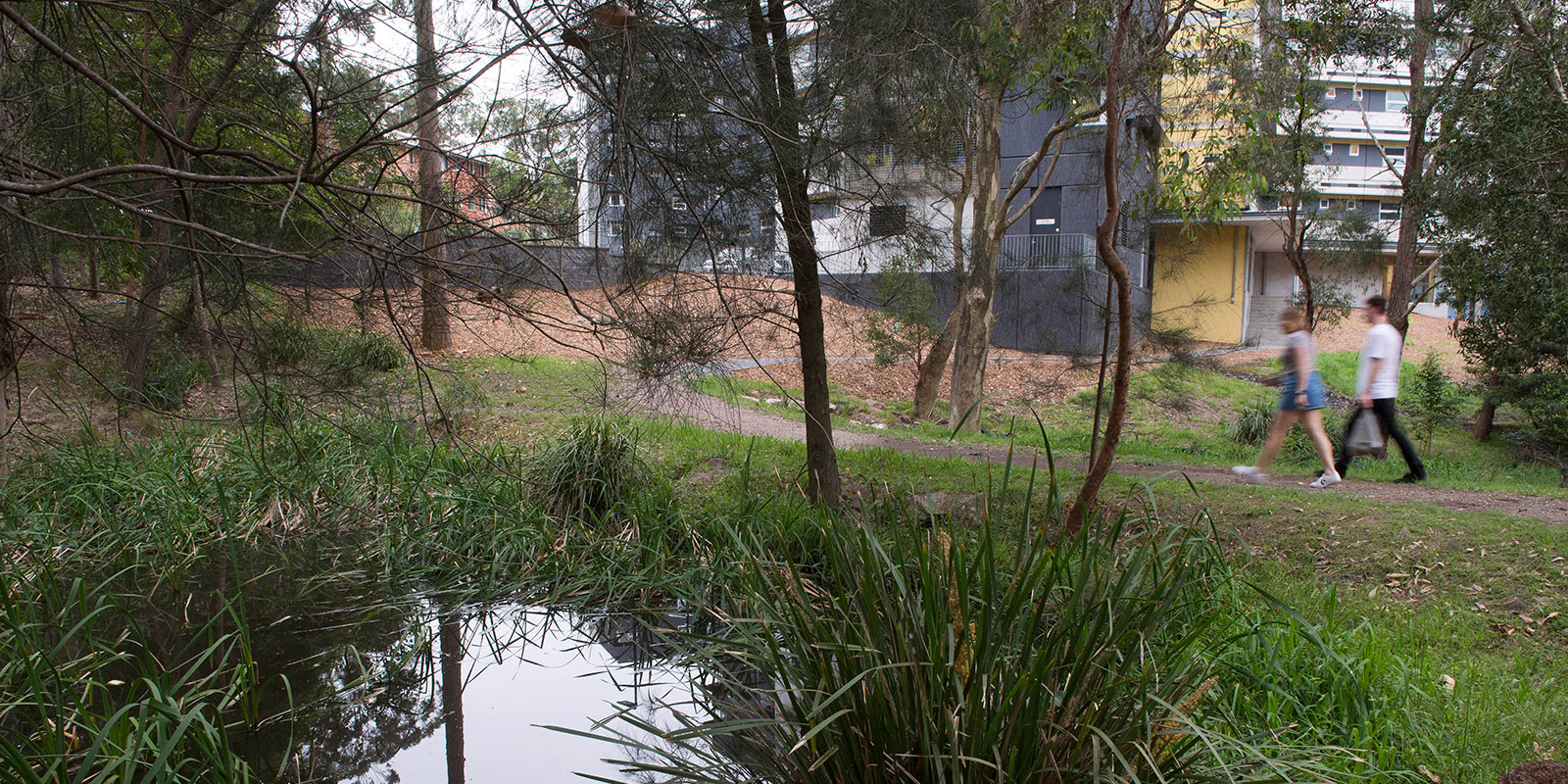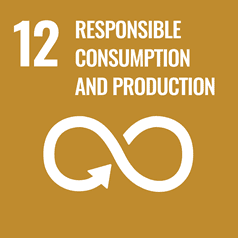

Goal 12:
Responsible Consumption and Production
Policy Waste Disposal: Hazardous Materials
The University maintains a structured policy and procedural regime that governs identification, handling, control, disposal, and regulatory compliance for hazardous materials (including asbestos, chemicals, etc.). This is embedded in the Health, Safety & Wellbeing (HSW) / Health & Safety Management System, via Key Risk Area (KRA) documents, guidelines, and specific procedures.
In particular, the KRA 3.3: Asbestos and Hazardous Materials Management document sets out the guiding framework for managing hazardous building materials and is complemented by other procedures such as the Chemical Management Procedure and the Health and Safety Key Risk Area Procedures.
Policy / Procedural Framework
KRA 3.3: Asbestos & Hazardous Materials Management
- The document titled KRA 3.3 Asbestos and Hazardous Materials Management provides guidance on “identifying, assessing, controlling and documenting asbestos and asbestos containing materials, and other hazardous materials.”
- It is explicitly scoped to apply to all health, safety and wellbeing activities of staff, students, visitors, contractors, and underlies work done by or on behalf of the University, including on‑campus and off‑campus premises.
- Key elements include:
- Identification & Assessment
- Surveys are to be conducted to locate hazardous materials — e.g., asbestos containing materials (ACM), lead paint, synthetic mineral fibres (SMF), polychlorinated biphenyls (PCBs), ozone depleting substances (ODSs).
- The register is maintained, reviewed by regulatory schedule or every 5 years, and is updated whenever changes (removal, disturbance, deterioration) occur.
- The condition (friable/non‑friable), location, and risk condition are recorded, and areas that may be disturbed in future works are especially considered.
- Management Plans
- Based on survey outcomes, the University develops Asbestos or Hazardous Materials Management Plans (HMMPs) to eliminate or minimise risks "so far as is reasonably practicable."
- The plans include priorities, control measures, monitoring, and documentation obligations.
- Where removal is needed, special procedures specified for safety, contractor briefing, monitoring and clearance are required.
- Contractor and Work Process Controls
- Before any refurbishment, demolition, or repair work, Infrastructure & Facilities Services (IFS) must be informed so that contractors can be briefed about any hazardous materials and appropriate controls used.
- Contractors must have access to the Asbestos/Hazardous Materials register and be briefed on any risks.
- After removal or disturbance, cleaning, monitoring, and clearance certification must be done, and the register updated.
- Identification & Assessment
- The version of KRA 3.3 cited is Version 2, issued October 2023, reflecting a recent review and expansion to include a broader set of hazardous materials beyond asbestos.
Other Relevant Procedures / Policies
- Chemical Management Procedure
The University has a Chemical Management Procedure that outlines how chemicals, dangerous goods, and hazardous substances are to be procured, transported, stored, used, and disposed.
This complements KRA 3.3 by covering non‑building materials (lab chemicals, reagents, controlled substances, etc.). - Health & Safety (Work Health & Safety) / HSMS Framework
The University’s Health and Safety Management System (HSMS) framework provides the overarching governance for risk management, procedural integration, consultation, training, monitoring and audit.
Under it, the KRA documents form part of the Key Risk Area Procedures. For instance, KRA 3.3 is one of the KRA under “Resources Division” in the Key Risk Area Procedures document.
Also, KRA 1.1: Chemical Management is explicitly included among these procedures, covering chemical waste and disposal. - Hazardous Materials Registers & Public Disclosure
The University maintains hazardous materials registers for known or presumed materials (e.g. asbestos, lead paint, SMF) across its campuses and buildings.
Registers are updated as required by the hazardous materials management plan; this ensures ongoing disposal or management obligations are tracked. - Signage / Labelling Projects
To support safe practice, the University is rolling out a hazardous building materials signage installation project. This involves placing labels and signs in areas with known or suspected hazardous materials to alert contractors and users to exercise care, especially during works.
The signage helps prevent inadvertent disturbance of hazardous materials, which is a critical control in waste or material handling. - Risk Management Policy
This policy provides direction for general health and safety risk identification, assessment, control, and review processes.
It supports the approach of identifying hazards (including hazardous materials), assessing risks, applying control measures in hierarchy (elimination, substitution, engineering, administrative, PPE), and monitoring controls.
This policy was effective from the 16th of December 2019 and was reviewed in December 2024.
Our University does not rely on one isolated document; rather, a suite of policies, procedures and registers integrate to ensure that hazardous materials and their waste are properly managed.
Application & Practice in 2024
Campus Registers & Updates
- The University’s hazardous materials register is publicly accessible for contractors and staff, listing known locations of hazardous materials (including ACM, lead paint, SMF) across different campuses (Callaghan, Newcastle City, Central Coast).
- These registers are updated as required under the University’s hazardous materials management plan, so they remained current in 2024.
- For example, the Callaghan Campus register was updated as recently as 24 May 2024 (and similarly for other campuses).
Signage & Risk Communication
- The University is actively installing hazardous material signage across its campuses, with phases targeting areas where work is likely, to alert to potential risks from materials.
- The signage is part of compliance with NSW Work Health & Safety Regulation 2017 that requires organisations to manage hazardous building materials.
- The signage project is phased to minimise disruption to university operations, but priority is being given to areas where contractors may need to disturb materials.
Waste / Removal / Contract Work
- When refurbishment, demolition or repair work is to be carried out, the KRA 3.3 protocol mandates consulting the hazardous materials register, briefing contractors, applying proper control and removal procedures, monitoring, cleaning and ensuring clearance certification before work completion.
- Removal of hazardous materials is done under controlled conditions; after disturbance or removal, monitoring and certification (e.g. by hygienists) must occur before reoccupation.
- The register is then updated to reflect any removal or changes.
Integration with Broader Risk & Safety Management
- The general risk management processes (via HSG 3.1) require hazard identification and assessment before tasks commence, including tasks that may disturb hazardous materials.
- The HSMS Framework ensures oversight, audit, incident management, review cycles, and alignment with ISO 45001 principles.
- The University uses internal systems (e.g. incident reporting, audits) to detect, manage and improve practices dealing with hazardous materials.
Element 1 - Leadership, Commitment and Governance PDF, 159.6 KB
Element 2 - Consultation and Communication PDF, 152.13 KB
Element 3 - Risk Management PDF, 155.47 KB
Element 4 - Training and Competence PDF, 152.93 KB
Element 5 - Incident and Injury Management PDF, 155.15 KB
Element 6 - Contractors and Suppliers PDF, 188.39 KB
Element 1: Leadership, Commitment and Governance
- HSG 1.1 Leadership and Regulatory Requirements PDF, 240.96 KB
- HSG 1.2 Roles and Responsibilities PDF, 258.74 KB
- HSG 1.3 Due Diligence PDF, 289.6 KB
- HSG 1.4 Objectives, Targets, Plans and Performance Measures PDF, 219.96 KB
Element 2: Consultation and Communication
- HSG 2.1 Consultation and Communication PDF, 282.63 KB
- HSG 2.2 Health and Safety Committees PDF, 216.74 KB
Element 3: Risk Management
- HSG 3.1 Health and Safety Risk Management PDF, 400.02 KB
- HSG 3.2 Managing Change PDF, 238.45 KB
- HSG 3.3 Health and Safety in the Design of Infrastructure Projects PDF, 193.58 KB
- HSG 3.4 Wellbeing PDF, 231.1 KB
Element 4: Training and Competence
- HSG 4.1 Pre-employment Assessment Against Inherent Requirements PDF, 225.61 KB
- HSG 4.2 Health, Safety and Wellbeing Induction, Training and Competency PDF, 241.82 KB
Element 5 Incident and Injury Management
- HSG 5.1 Health, Safety and Wellbeing Event Notification and Investigation PDF, 317.49 KB
- HSG 5.2 First Aid PDF, 344.09 KB
- HSG 5.3 Emergency Response PDF, 252.05 KB
- HSG 5.4 Return to Work Program - Injury Management PDF, 448.31 KB
- HSG 5.5 Non-workers Compensation Illnesses and Injuries PDF, 334.41 KB
Element 6: Contractors and Suppliers
- HSG 6.1 Contractor Health and Safety Management PDF, 295.53 KB
- HSG 6.2 Health and Safety in Procurement PDF, 224.89 KB
Element 7: Records Management
- HSG 7.1 Health and Safety Records and Document Control PDF, 289.42 KB
- HSG 7.2 Health and Safety Reporting PDF, 186.4 KB
Element 8: Monitoring, Review and Audit
KRA 2.1: Manual Handling and Ergonomics
KRA 2.2: Smoke-free University Environments
KRA 2.3: Rescinded, refer to Flexible Work Policy
KRA 2.4: Working alone or in Isolated Situations
KRA 2.5: Travelling on University Business
KRA 2.6: Managing Behavioural Risks
KRA 2.8: Rescinded, refer to HSG 3.4 Wellbeing
KRA 2.9: Guidelines for Employee Assistance Program (EAP)
KRA 2.11: Identifying and Managing Psychosocial Hazards in the Workplace
Application for purchase of a radiation source
Fieldwork Medical Information Form
First Aid Officer Induction Form
First Aid Risk Assessment Template
General Work Area Inspection Schedule
Hazardous Chemicals and Dangerous Goods Risk Assessment
Hazardous Waste Disposal Guide
Health and Safety Committee Meeting Agenda Template
Health and Safety Committee Meeting Minutes Template
Health and Safety Committee Terms of Reference
Health and Safety Compliance Activity Action Plan
Health and Safety Operational Change Risk Register Template
Health and Safety Risk Assessment Template
Health and Safety Risk Register Template
Health and Safety Travel Risk Assessment Template
Health, Safety and Wellbeing Plan Template
Health, Safety and Wellbeing Safety Alert Template
Health, Safety and Wellbeing Training Needs Analysis Matrix
HSMS Consultation and Amendment Request Form
Induction Checklist – Contractors and Visitors
Induction Checklist – Staff and Students
Manual Handling Risk Assessment Template
Offsite Visit and Interview Health and Safety Checklist
Offsite Visit and Interview Health and Safety Guide
OGTR Certified Facility Authorised Person Form
Overhead Travelling Crane Pre-operational Checklist
Plant and Equipment Risk Assessment Template
Plant and Equipment Inspection and Testing Schedule
Position Screening Health and Safety Risk Assessment
Psychosocial Risk Assessment Survey Feedback Form
Request for disposal of human remains - Information sheet for police
Respirator selection and Fit-testing Guide
SCUBA Dive Operations Guide (DRAFT)
Serious Incident Investigation Report Template
Standard Operating Procedure (SOP) Template
Student Placement Health, Safety and Wellbeing Checklist
The University of Newcastle acknowledges the traditional custodians of the lands within our footprint areas: Awabakal, Darkinjung, Biripai, Worimi, Wonnarua, and Eora Nations. We also pay respect to the wisdom of our Elders past and present.